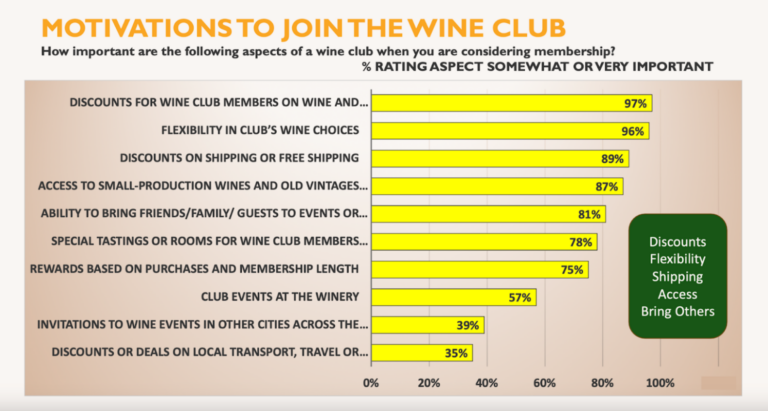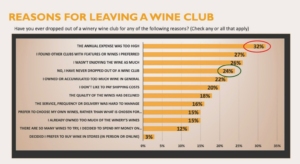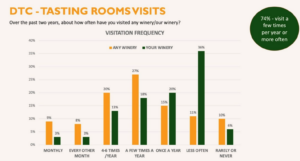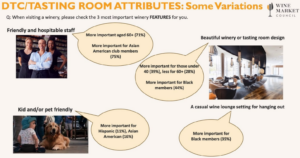
Wine clubs are the beating heart for many small- to medium-sized wineries since they account for 86% of direct sales for the average U.S. winery, according to industry data. Due to their vital importance, the Wine Market Council commissioned a study this past spring to see just what motivates the average wine club member and came up with some compelling data and insights wine marketers can leverage.
Wine Market Council Research Director Christian Miller estimated that the group’s survey of 9,108 wine club members drew from 24 to 30 individual wineries. It included at least three respondents from every state.
Top Picks: Price and Selection
Unsurprisingly, wine club members’ top four wine club favorites were related to pricing and selection. Specifically, they cited discounted prices on wines and shipping as well as flexibility in choosing their club wines and access to special small lot wines or library selections as key features.
Paradoxically, 57% said club events at the winery were a draw, even though only 32% attended club events. Respondents were more motivated by other socializing features, like the ability to bring friends along to events or having access to club-only rooms or tastings.
While 88% joined when they were visiting the winery or after a visit, remarkably, 5% joined without having visited and 2% joined after a wine dinner or tasting in their region.
Wine Club Members Are Not the Average Wine Drinker
Wine club members stand out from the average wine drinker for their wealth. Said Wine Market Council President Liz Thach, who moderated the online webinar, “46% make over $200,000 per year. When you compare that to the average annual income in the United States, $59,000, that’s pretty high.”
An income of $200,000 puts those individuals in the top 12% of U.S. household incomes.
The average wine club member is 59 years old. Though the majority are still working full time (54%), 40% are retired.
Though California had the highest number of club members (36% of the sample), the next four states (New York, Florida, Texas, Illinois) accounted for 17% of club members in the survey. The rest (47%) were from other states, meaning club members are widely dispersed.
Wine club members are also frequent flyers; 72% are members of more than one club.
“These are people who love wine,”
said Thach.

The Downside
But it’s not always long-lasting love, the data showed. According to the Silicon Valley Bank DTC survey in 2024, wine club churn rates are up; 19% of members leave. A Wine Business Monthly Tasting room survey found visitation and wine club recruitment declined by 4% in 2023, a cause for concern.
Reasons for leaving a wine club were varied, with 32% saying the expense was too high, while 27% said they switched to another club they liked better.
Tasting Room Visits
Most respondents visit a winery more than once a year, the survey found.
What drives repeat visits? Variety and tasting. 55% of respondents liked to be able to choose from a variety of experiences at the winery, the survey found. 48% liked being able to taste older or rare vintages. Wine and food pairings were also popular, with 42% rating that important, as were personal or private tastings (42%).
22% were interested in owner tours. Another 20% were interested in vineyard tours.

What Tasting Room Visitors Are Looking For
The survey also asked respondents which attributes were most important when visiting a winery. Hospitality was by far the top-rated feature.
Some Hispanic and Asian American respondents were more apt to be looking for kid- and pet-friendly wineries, while 44% of black wine club members said a beautiful winery or tasting room was important. 35% of black wine club members wanted a casual wine lounge for hanging out.
Activities like bocce ball, art exhibits and hikes were not highly rated overall, with just 9% citing that as important.
A Positive Demographic Shift in Progress
When it comes to planning to visit a winery, black wine club members outnumbered all other ethnic groups, with 55% saying they intended to visit winery tasting rooms.
Only 15% of boomers said they intended to visit a winery, compared to 31% of Gen X (age 43 to 58) and 36% of millennials (age 27 to 42).
Said Miller, “If you look at those who intend to visit, you are looking at an upcoming wave of quite a different demographic group, much younger, much more diverse… So we could be facing a pretty fast demographic shift here in terms of visitation if these people do what they say they’re going to do.”

Wine Club Members as Social Media Ambassadors
Researchers said they hoped the data would help marketers to be more effective in attracting and retaining wine club members.
Thach said, “Happily, 78% [of wine club members] purchase more wine from your winery website [in addition to the club shipments]. That’s what you want.”
But that’s not all they do, she said; they add value to your brand.
“Even better, in my opinion, 78% have posted a photo image or comment on social media. 77% recommend your wine to a friend.”
“They’re loving your wine and they’re out there talking about it. I hope you are tracking that. I hope you know what’s happening with your social media and people talking about you online,” she said.











